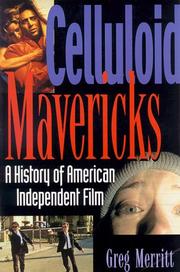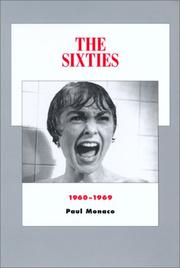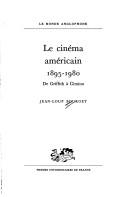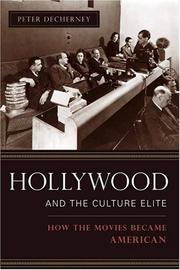| Listing 1 - 10 of 17 | << page >> |
Sort by
|

ISBN: 1560252324 Year: 2000 Publisher: New York Thunder's Mouth Press
Abstract | Keywords | Export | Availability | Bookmark
 Loading...
Loading...Choose an application
- Reference Manager
- EndNote
- RefWorks (Direct export to RefWorks)

ISBN: 0520238044 9780520238046 Year: 2003 Volume: 8 Publisher: Berkeley, Calif. University of California Press
Abstract | Keywords | Export | Availability | Bookmark
 Loading...
Loading...Choose an application
- Reference Manager
- EndNote
- RefWorks (Direct export to RefWorks)
Amid the turbulence of political assassinations, the civil rights struggle, and antiwar protests, American society was experiencing growing affluence and profound cultural change during the 1960s. The film industry gradually redirected its energies, resulting in a distinctive break from traditional business and stylistic practice and emergence of a new "cinema of sensation." Feature films became faster-paced and more graphic, the antihero took his place alongside the classic Hollywood hero, and "downer" films like 'Midnight Cowboy 'proved as popular as those with upbeat fare. Paul Monaco gives a sweeping view of this exhilarating decade, ranging from the visceral sensation of 'Bonnie and Clyde, 'to the comic-book satire of 'Dr. Strangelove, 'to the youthful alienation of 'The Graduate. '
Film --- anno 1960-1969 --- United States --- Motion picture industry --- Motion pictures --- History --- History. --- Motion picture industry - United States - History --- Motion pictures - United States - History --- United States of America

ISSN: 01816063 ISBN: 2130374875 9782130374879 Year: 1983 Publisher: Paris : PUF - Presses Universitaires de France,
Abstract | Keywords | Export | Availability | Bookmark
 Loading...
Loading...Choose an application
- Reference Manager
- EndNote
- RefWorks (Direct export to RefWorks)
Film --- United States --- Motion pictures --- Cinéma --- History --- Histoire --- Cinéma --- Motion pictures - United States - History --- United States of America --- CINEMA --- ETATS-UNIS --- HISTOIRE
Book
ISBN: 1280493453 9786613588685 0813548454 9780813548456 9780813545820 081354582X 9780813546971 0813546974 Year: 2009 Publisher: New Brunswick, NJ : Rutgers University Press,
Abstract | Keywords | Export | Availability | Bookmark
 Loading...
Loading...Choose an application
- Reference Manager
- EndNote
- RefWorks (Direct export to RefWorks)
Americans flocked to the movies in 1945 and 1946ùthe center point of the three-decade heyday of the studio system's sound era. Why? Best Years is a panoramic study, shining light on this critical juncture in American historyand the history of American cinemaùthe end of World War II (1945) and a year of unprecedented success in Hollywood's "Golden Age" (1946). This unique time, the last year of war and the first full year of peace, provides a rich blend of cinema genres and typesùfrom the battlefront to the home front, the peace film to the woman's film, psychological drama, and the period's provocative new style, film noir. Best Years focuses on films that were famous, infamous, forgotten, and unforgettable. Big budget A-films, road shows, and familiar series share the spotlight. From Bergman and Grant in Notorious to Abbott and Costello in Lost in a Harem, Charles Affron and Mirella Jona Affron examine why the bond between screen and viewer was perhaps never tighter. Paying special attention to the movie-going public in key cities--Atlanta, New York, Boston, Honolulu, and Chicago--this ambitious work takes us on a cinematic journey to recapture a magical time.
Book
ISBN: 9782753583740 2753583749 Year: 2022 Publisher: Rennes : Presses universitaires de Rennes,
Abstract | Keywords | Export | Availability | Bookmark
 Loading...
Loading...Choose an application
- Reference Manager
- EndNote
- RefWorks (Direct export to RefWorks)
Hollywood, fin des années 1960. Une nouvelle génération de cinéastes, majoritairement venus de la télévision ou des écoles de cinéma, prend le pouvoir au sein des studios. Parmi eux, Martin Scorsese, Brian De Palma, Francis Ford Coppola, Arthur Penn, Sam Peckinpah, Robert Altman, William Friedkin, Dennis Hopper, Mike Nichols, Alan J. Pakula, Sidney Lumet, et bien d'autres encore. Du fait de leurs formations et de leurs influences, ces réalisateurs modifient en profondeur le style cinématographique hollywoodien. Ils recourent à des techniques, des formes et des figures jusque-là peu ou pas employées par le cinéma américain : le zoom, le split screen, la caméra portée, les dialogues qui se chevauchent, le ralenti, les montages ultrarapides... Tous ces procédés contribuent à renouveler la fabrique et la conception du « point de vue », c'est-à-dire des positions assignées aux spectateurs par la composition des plans, les mouvements de caméra ou le montage. Il en résulte, entre autres, d'importantes transformations dans la relation que les spectateurs entretiennent avec les films, dans la manière dont ils s'y projettent, dans ce qui leur est donné à comprendre, à ressentir et à penser. Ce sont ces transformations, les formes qu'elles empruntent, leur logique et leurs enjeux, que cet ouvrage se propose d'examiner.
Cinéma --- Technique --- Cinéma -- Technique --- Motion pictures - United States - History - 20th century --- Motion pictures - Aesthetics --- Motion pictures --- Cinéma --- History --- History. --- Production and direction --- Technological innovations.
Book
ISBN: 1282899783 9786612899782 0748643214 9780748643219 9781282899780 9780748638574 0748638571 9780748638581 074863858X 6612899786 Year: 2010 Publisher: Edinburgh : Edinburgh University Press,
Abstract | Keywords | Export | Availability | Bookmark
 Loading...
Loading...Choose an application
- Reference Manager
- EndNote
- RefWorks (Direct export to RefWorks)
At the end of World War II, Hollywood basked in unprecedented prosperity. Since then, numerous challenges and crises have changed the American film industry. Nevertheless, at the start of a new century, Hollywood's worldwide dominance remains intact& mdash;indeed, in today's global economy, the products of the American entertainment industry (of which movies are now only one part) are more ubiquitous than ever. How does today's Hollywood& mdash;embedded within transnational media conglomerates like NewsCorp., Sony, and Viacom& mdash;differ from the legendary studios of its Golden Age? What are
Hollywood (Los Angeles, Calif.) -- History -- 20th century. --- Hollywood (Los Angeles, Calif.) -- History -- 21st century. --- Motion picture industry -- California -- Los Angeles -- History -- 20th century. --- Motion picture industry -- California -- Los Angeles -- History -- 21st century. --- Motion pictures -- United States -- History -- 20th century. --- Motion pictures -- United States -- History -- 21st century. --- Motion pictures --- Motion picture industry --- Film --- Music, Dance, Drama & Film --- Film industry (Motion pictures) --- Moving-picture industry --- Cultural industries --- Cinema --- Feature films --- Films --- Movies --- Moving-pictures --- Audio-visual materials --- Mass media --- Performing arts --- History --- History and criticism
Book
ISBN: 0804782202 9780804782203 0804773009 9780804773003 0804773009 9780804773003 0804773017 9780804773010 Year: 2012 Publisher: Palo Alto : Stanford University Press,
Abstract | Keywords | Export | Availability | Bookmark
 Loading...
Loading...Choose an application
- Reference Manager
- EndNote
- RefWorks (Direct export to RefWorks)
Depictions of Asian American men as effeminate or asexual pervade popular movies. Hollywood has made clear that Asian American men lack the qualities inherent to the heroic heterosexual male. This restricting, circumscribed vision of masculinity-a straitjacketing, according to author Celine Parreñas Shimizu-aggravates Asian American male sexual problems both on and off screen. Straitjacket Sexualities: Unbinding Asian American Manhoods in the Movies looks to cinematic history to reveal the dynamic ways Asian American men, from Bruce Lee to Long Duk Dong, create and claim a
Asian American men in motion pictures. --- Masculinity in motion pictures. --- Motion pictures - United States - History. --- Motion pictures -- United States -- History. --- Sex in motion pictures. --- Music, Dance, Drama & Film --- Film --- Asian American men in motion pictures --- Masculinity in motion pictures --- Sex in motion pictures --- Motion pictures --- Cinema --- Feature films --- Films --- Movies --- Moving-pictures --- Audio-visual materials --- Mass media --- Performing arts --- Sex in moving-pictures --- Erotic films --- Pornographic films --- History --- History and criticism
Book
ISBN: 9782918272113 2918272116 Year: 2010 Publisher: Châtillon : Pix'n love,
Abstract | Keywords | Export | Availability | Bookmark
 Loading...
Loading...Choose an application
- Reference Manager
- EndNote
- RefWorks (Direct export to RefWorks)
Motion pictures and video games --- Motion pictures --- Video games industry --- Leisure industry --- History --- Motion pictures - United States - History --- Video games industry - United States - History --- Leisure industry - United States - History --- Cinéma numérique --- Adaptations cinématographiques --- Jeux vidéo --- Produits dérivés (marketing) --- Industrie culturelle --- Cinéma --- États-Unis --- 1970-2000 --- 1990-....
Book
ISBN: 9781479861958 1479861952 9781479833528 1479833525 Year: 2015 Publisher: New York New York University Press
Abstract | Keywords | Export | Availability | Bookmark
 Loading...
Loading...Choose an application
- Reference Manager
- EndNote
- RefWorks (Direct export to RefWorks)
"The way a society punishes demonstrates its commitment to standards of judgment and justice, its distinctive views of blame and responsibility, and its particular way of responding to evil. Punishment in Popular Culture examines the cultural presuppositions that undergird America's distinctive approach to punishment and analyzes punishment as a set of images. It recognizes that the semiotics of punishment is all around us, in both 'high' and 'popular' culture iconography, in novels, television, and film. This book brings together distinguished scholars of punishment and experts in media studies in an unusual juxtaposition of disciplines and perspectives. Americans continue to lock up more people for longer periods of time than most other nations, to use the death penalty, and to racialize punishment in remarkable ways. How are these facts of American penal life reflected in the portraits of punishment that Americans regularly encounter on television and in film?And how are images of punishment received by their audiences? It is to these questions that Punishment in Popular Culture is addressed"
Punishment in motion pictures. --- Punishment in popular culture --- Mass media and criminal justice --- Criminal justice and mass media --- Criminal justice, Administration of --- Motion pictures --- Punishment in motion pictures --- Punishment on television --- Television broadcasting --- History --- Motion pictures - United States - History --- Television broadcasting - United States

ISBN: 0231133766 9780231133777 0231133774 0231508514 9780231133760 Year: 2005 Volume: *9 Publisher: New York : Columbia University Press,
Abstract | Keywords | Export | Availability | Bookmark
 Loading...
Loading...Choose an application
- Reference Manager
- EndNote
- RefWorks (Direct export to RefWorks)
As Americans flocked to the movies during the first part of the twentieth century, the guardians of culture grew worried about their diminishing influence on American art, education, and American identity itself. Meanwhile, Hollywood studio heads were eager to stabilize their industry, solidify their place in mainstream society, and expand their new but tenuous hold on American popular culture. Peter Decherney explores how these needs coalesced and led to the development of a symbiotic relationship between the film industry and America's stewards of high culture. Formed during Hollywood's Golden Age (1915-1960), this unlikely partnership ultimately insured prominent places in American culture for both the movie industry and elite cultural institutions. It redefined Hollywood as an ideal American industry; it made movies an art form instead of simply entertainment for the masses; and it made moviegoing a vital civic institution. For their part, museums and universities used films to maintain their position as quintessential American institutions. As the book delves into the ties between Hollywood bigwigs and various cultural leaders, an intriguing cast of characters emerges, including the poet Vachel Lindsay, film producers Adolph Zukor and Joseph Kennedy, Hollywood flak and censor extraordinaire Will Hays, and philanthropist turned politician Nelson Rockefeller. Decherney considers how Columbia University's film studies program helped integrate Jewish students into American culture while also professionalizing screenwriting. He examines MoMA's career-savvy film curator Iris Barry, a British feminist once dedicated to stemming the tide of U.S. cultural imperialism, who ultimately worked with Hollywood and the U.S. government to fight fascism and communism and promote American values abroad. Other chapters explore Vachel Lindsay's progressive vision of movies as reinvigorating the public sphere through film libraries and museums; the promotion of movie connoisseurship at Harvard and other universities; and how the heir of a railroad magnate bankrolled the American avant-garde film movement. Amid ethnic diversity, the rise of mass entertainment, world war, and the global spread of American culture, Hollywood and cultural institutions worked together to insure their own survival and profitability and to provide a coherent, though shifting, American identity.
Motion picture industry --- Motion pictures --- History --- Social aspects --- United States --- Social life and customs --- #SBIB:309H1313 --- Geschiedenis en/of organisatie van het filmwezen: algemeen en per land (met inbegrip van de rol van het filmwezen in de ontwikkelingsproblematiek) --- 20th century --- Culture in motion pictures --- Culture in motion pictures. --- History. --- Motion picture industry - United States - History --- Motion pictures - United States - History --- Motion pictures - Social aspects - United States --- United States - Social life and customs - 20th century
| Listing 1 - 10 of 17 | << page >> |
Sort by
|

 Search
Search Feedback
Feedback About
About Help
Help News
News